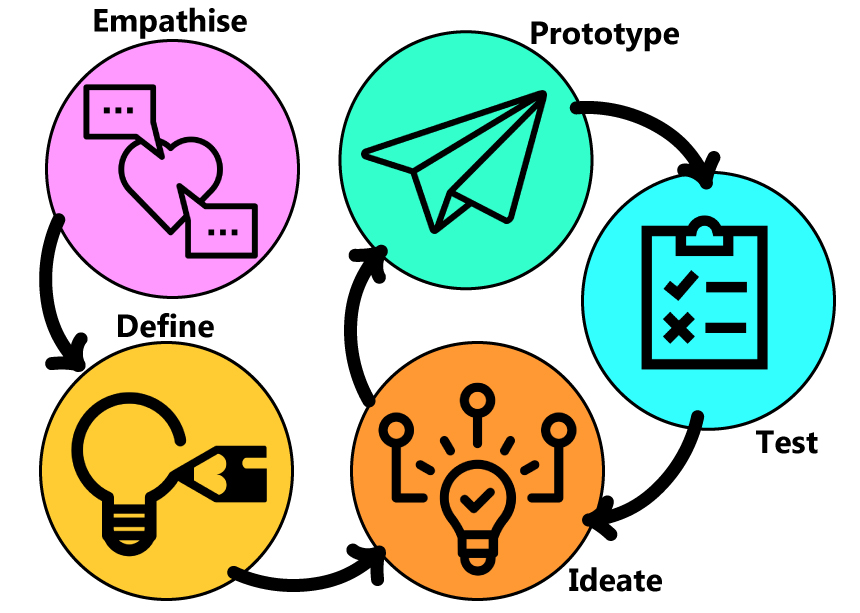Thinking like a Designer
Learning development in a creative faculty
A faculty-based learning developer (LD) must accommodate the full range of subjects and types of learners in their specific contexts. The ‘design thinking’ (DT) five basic stages of ‘empathise, define, ideate, prototype, test’ that I am about to look at more closely are often criticised as being too simple. But simplicity is often underrated and I suggest that we should accept them as a sound and well-established catalyst for learning development.

Creative students in most of the subjects offered by the faculty of CCI will come across ‘design thinking’ at an early stage in their studies. The ubiquity and foundational principles of design theory provide a useful common starting point for planning sessions for CCI students. Further, the structure and many of the characteristics of the model are shared with the principles of one-to-one academic skills session. An understanding of the process can equally help to investigate best ways of dealing with student issues in a session.
One significant difference between LD and DT is that the ‘customers’ from the original design text are ‘students’ in our settings – even though a lot of people nowadays argue that paying students are ‘customers’. As an LD I have to disagree since our work is based on student-centred principles in pedagogy.
Here is a closer look at design thinking = thinking of a designer/ creative student in five stages:
1. ‘Empathise’
In LD lingo, this refers to taking a holistic approach. The first stage in the (design) process is to understand our clients: how they think, how they feel and what’s important to them.
This means for the Learning developer to engage with them on an ongoing basis, observing their behaviour, asking open questions and actively listening to what they have to say. (Rather than beginning with the problem presented and jumping straight into possible solutions, start by asking what your students need. That leaves me hoping that they will conclude it is advice rather than a quick fix solution they are after).
So often, a stressed out student presents themself with “This is what I have done so far and I cannot see the wood for the trees. Oh, and my deadline is tomorrow or the day after“. Ouch! Especially the latter. How then do I calm someone down who is not prepared/able to take a step back because of the time pressure of an immediate deadline? Discussing the bigger picture is so important; it is always worth a try.
However ‘empathising’ is something entirely different again. This actually means, by definition, to step into someone’s shoes or at least speak the same language. It must be said, that the actual meaning of ‘empathy’ might be misplaced here. Bloom argues that actual empathy would make a doctor unfit to operate. He draws our attention to the ‘utilitarian principles where the effective allocation of resources trumps the warm glow of a more singular and intimate concern’. Hmm, this certainly offers food for further thoughts.
There is so much in here to take away. As a start, first impressions at the beginning of a session are so important. Helping students to take a step back, and breathe in, which actually calms them down and makes them realise their haste (well, most of them), is the anchor point to ‘engagement’. In a millisecond, the tutor must judge the situation and observe the stressed out behaviour the student presents. Moreover, well, we are not trained psychologists nor counsellors. I do, however, recognise the elements required for my job to deal with these ever so crucial opening situations.
Get them talking! What? How? Why? My favourite opener is to question their stance on where the student sees a piece of assessment in connection to the whole module, followed by the purpose of it (why do I need to do this?). I have always called it zooming out of the piece and then coming back to it. (Not many remember the title of the module.) Can the student clearly vocalise what the task entails? Every so often it is a rushed judgement by the student ‘I answer what I think is needed’. Considering the high percentage of learners with dyslexia in a creative environment (plus students with Aspergers, anxieties, etc), it is not surprising that many misinterpret a task at the first attempt.
2. ‘Define’
Did the student or client understand the brief/ task/ basic concepts?
At this second stage, the student is encouraged to zoom in on the task. This means defining the problem, getting to the root after having discussed the bigger picture. (Here begins the unpacking of what I have learned about my students in these vital opening minutes during empathising).
We are now identifying the task together and are encouraged as designers to create a haptic, visual display of the findings using Post-it notes, photos, quotes, mindmaps, etc. By getting everything up on a table, the floor or a wall and letting the student take the helm, they can identify patterns and expand their own insights by thinking aloud and sharing. The goal is to arrive at a clear, actionable definition of the problem that will provide the focus for the student. I am, at this stage, facilitating the learner’s comprehension and hope to have ignited the fire.
3. ‘Ideate’
Next comes idea generation – sometimes called brainstorming or an ideas shower. Once the problem is ‘framed’, as designers call it, the student can start to explore potential solutions. Ideation may be defined as the activity of forming ideas in the mind.
Initially, it is important to consider a wide range of possibilities. Even if the solution might immediately seem obvious, design thinking requires that we create and consider a variety of options and encourages divergent thinking. Ideation is not about determining the ‘best’ idea or the ‘right’ idea, but coming up with as many different ways of approaching the problem as possible (at this stage).
Designers usually elect at least three ideas to carry forward (to present to the client). Here, our student is encouraged to go for the one considered, discussed, chosen for the task in hand (we will have seldom time for three).
The input of LD here might be – depending on the needs of the individual – to encourage further thinking about resources, time management, structuring the piece and/or deeper critical thinking.
4. ‘Prototype’
Let’s call this ‘the first draft’. Before the students can test out their ideas, they need to ‘build prototypes’ i.e. produce a basic artefact or draft if it’s a written piece of work.
In design terms, a prototype is anything a user can interact with: a wall of Post-it notes, a storyboard, a role-playing activity or a piece of software. Ideally, each prototype/draft should require few resources to create. In our case, this might be a draft of writing the tutor asked for mid-way through to the hand-in deadline.
The LD tutor would be acting as a sounding board for the suitability of the text, question the structure, clarity (and maybe originality) of the work. Important here – student are ‘allowed to make mistakes’, get stuck, get frustrated, etc. and learn from it; keep what’s worthwhile.
5. ‘Test’
The testing phase is where the student seeks feedback from peers and/or subject tutor. This is another opportunity to understand their own needs. The (design) rule of thumb is ‘show, don’t tell’. The onus here should be on the student to explain, demonstrate and subsequently make progress.
Maybe in LD terms it should be students ‘show & tell’? A big no-no for the tutor here is (but often expected by the student) proofreading. The tutor does not correct (every) typo or grammar mistake, in fact, takes a back seat. Only if clarity is compromised, questions are asked. The student takes full ownership at this stage – does it work, flow, make sense, have a coherent structure? Necessary academic conventions and elements are questioned e.g. how to cite and reference.
Finally, it is ‘socio-cognitive relevance’ that drives a student to come out of an LD session and feel GOOD about it. How useful was it for me? + how meaningful? + perception at the time. Pragmatism is of essence here but also a link to self-efficacy as again linked back to the bigger picture:
Basic design thinking has its value for the development of learning especially in a creative faculty. Some people call it clichéd, some overused, but I trusted and investigated it in relation to my area of academic skills development. I drew out the original methodological ‘bones’ and applied them to a face-to-face session that students could benefit from as part of their own learning experience. Especially the ideation stage requires time for thinking and digesting ideas. Overall, it is a useful basic framework that helps anybody to generate creative ideas and is worth using as a template.
In a creative faculty, learning developers possess the tools to facilitate and coach students to see and use strong parallels between design and critical academic thinking.
References
Institute of Design at Stanford. (n.d.). An Introduction to Design Thinking. https://dschool-old.stanford.edu/sandbox/groups/designresources/wiki/36873/attachments/74b3d/ModeGuideBOOTCAMP2010L.pdf
Malamed, C. (2018, 16 March). A designer addresses criticism of design thinking. Learning Solutions. https://learningsolutionsmag.com/articles/a-designer-addresses-criticism-of-design-thinking
Kilian, J., Sarrazin, H., & Seitz, B. (2016, 1 March). The power of design thinking. McKinsey Digital. https://www.mckinsey.com/business-functions/mckinsey-digital/our-insights/the-power-of-design-thinking#
University of Portsmouth. (2019). Learning development toolkit: An introduction to design thinking. https://app.goodpractice.net/#/uni-portsmouth-tfl/s/ff5c4a06
Vickers, S. (2017, 6 February). Against empathy by Paul Bloom; the empathy instinct by Peter Bazalgette: Review. The Guardian. https://www.theguardian.com/books/2017/feb/06/against-empathy-paul-bloom-the-empathy-instinct-peter-bazalgette-review
Image credits
Images adapted from the following designers from the Noun Project:
‘Empathise’ by Sumi Saengthong
‘Define’ by Jim Slatton
‘Ideate’ by Adrien Coquet
‘Prototype’ by Maxim Kulikov
‘Test’ by Shaa









Leave a Comment (note: all comments are moderated)